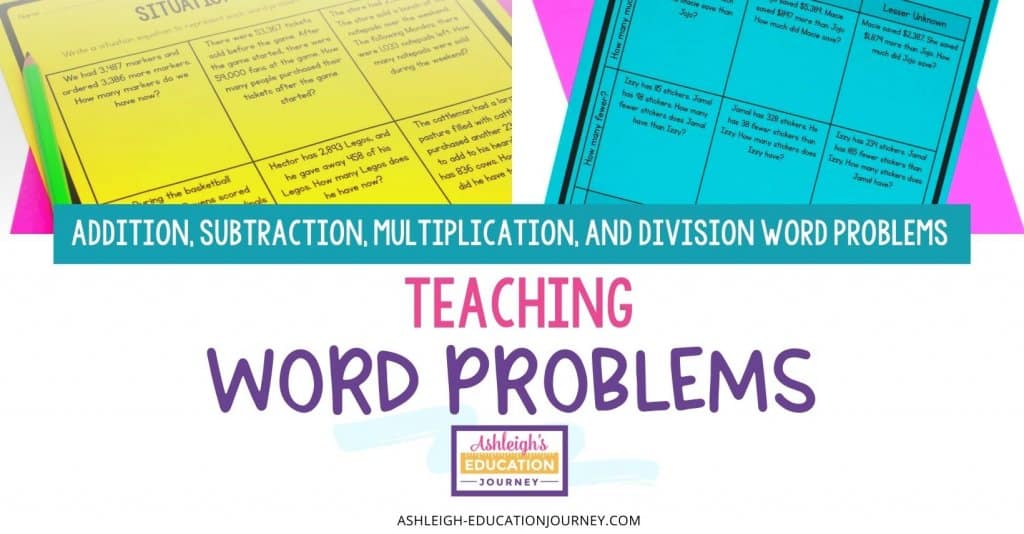
It’s no secret that addition, subtraction, multiplication, and division word problems present a considerable challenge to students. Students often rush through word problems and immediately try to find an answer, rather than thinking about the meaning of the problem. Students see a word problem and want to immediately grab the numbers and do something with them. Fortunately, there are things we can do that will allow students to develop an understanding of word problems.
In this post:
- How do I teach word problems?
- Addition and Subtraction Problems
- Action and Non Action
- Types of Action Word Problems
- Types of Nonaction Word Problems
- Situational Equations
- Multiplication and Division Problems
- Equal Groups
- Multiplication Comparison
- Error Analysis
How do I teach word problems?
I’ve found that it’s best to avoid teaching key words and strategies such as CUBES. Key words are not enough to solve a problem and can often lead students to an incorrect operation or a single operation where multiple operations are needed. Other procedural strategies omit the understanding of the situation of the problem.
In order for students to fully understand word problems, they must have opportunities to solve word problems using multiple representations. This allows students to understand the actions and relationships in the problem. Options for representation include:
- Concrete-using physical representations or acting out through modeling.
- Pictorial-pictures and diagrams can illustrate and clarify the actions and relationships in ways that words, even concrete representations, can’t.
- Symbolic-symbols can be operation signs or variables.
When students begin working with larger numbers, representing situations with a physical model becomes more challenging because it requires strategic grouping of units. In these situations, students may need to provide a key or additional explanation to their representations.
As students work, it is important to note when they are not representing the actual context and the quantities but are representing only the numbers in the problem. Not matching the problem situation to a model reveals that the student has not displayed operational sense in the solution. Operation sense is understanding all of the “work” that each operation can do. This extends to the use of appropriate representations for the action or relationship in the problem so that it represents an understanding of the situation.
Addition and Subtraction Problems
I begin the year with only addition and subtraction word problems. Even though upper elementary students typically have considerable experience with addition and subtraction word problems, these lessons are incredibly important.
Action and Non Action
One of the keys to understanding word problem is to recognize action and nonaction word problems. Action does not necessarily refer to movement but that something happens to the initial quantity in the problem. This is a great time to have students take turns acting out various word problems. I have students sort word problems into action and non action word problems.
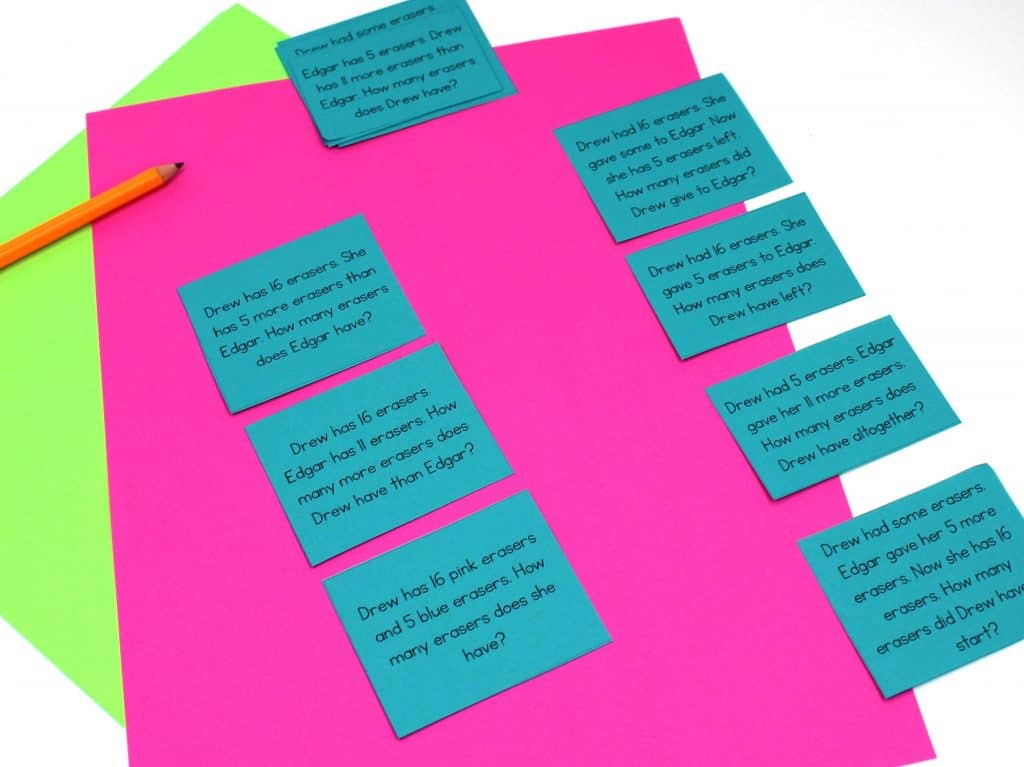
For extra practice, I have students complete the Action or Nonaction Word Problems sheet. In this practice page, students solve six addition and subtraction word problems. Then, they shade in the word problems that show action with green and the nonaction word problems with red.
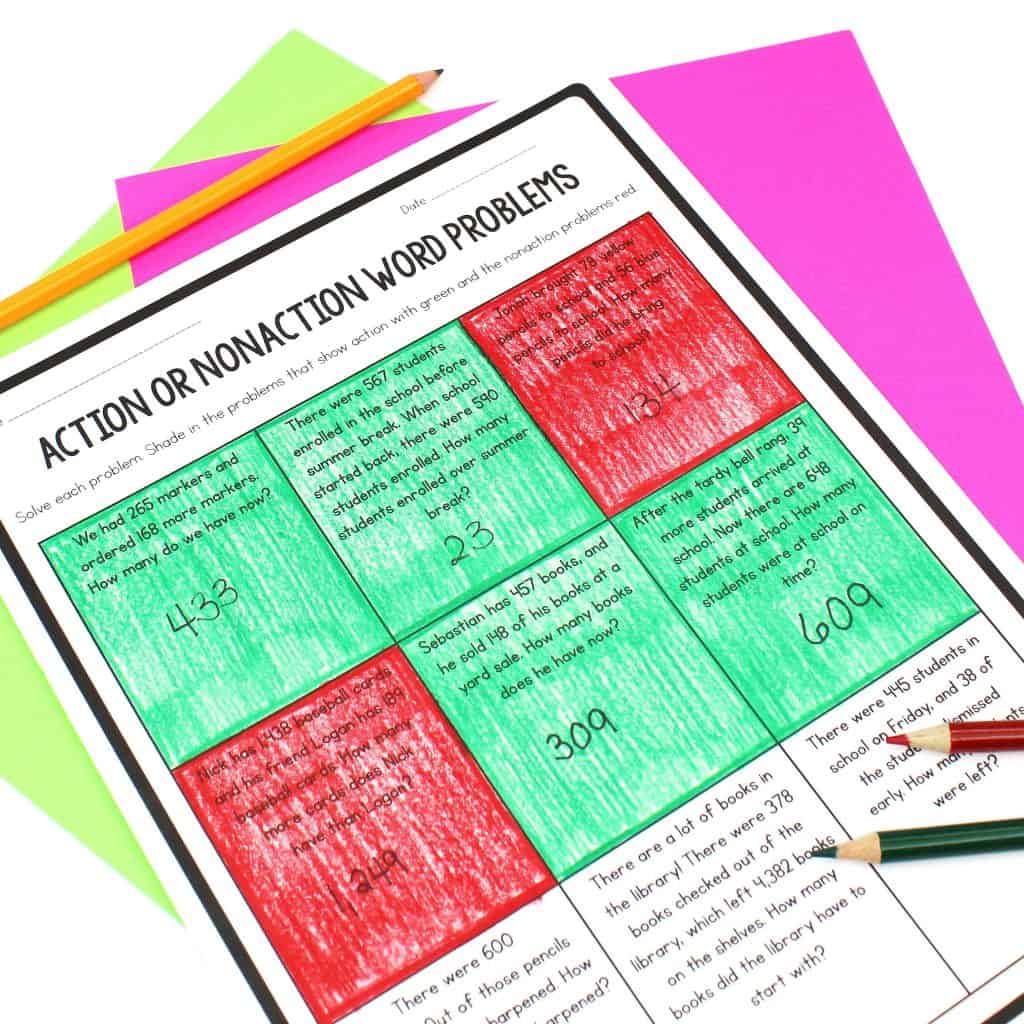
This may seem like an overly simplistic lessons, but it begins to build a foundation for more specific types of word problems. It’s best to not overwhelm students with too much, too soon.
Types of Action Word Problems
The next step is to have students understand the different types of action word problems. In this lesson, students can reuse the sorting cards and sort the action cards into joining and separating problems. This is often surprisingly challenging for students.
After students sort their cards, introduce the terms result unknown, change unknown, and start unknown. Go through each of the cards to determine what type of unknown the card includes.
Place six sheets of chart paper around the classroom. Label each sheet of chart paper with: Joining Start Unknown, Joining Change Unknown, Joining Result Unknown, Removing Start Unknown, Removing Change Unknown, Removing Result Unknown.
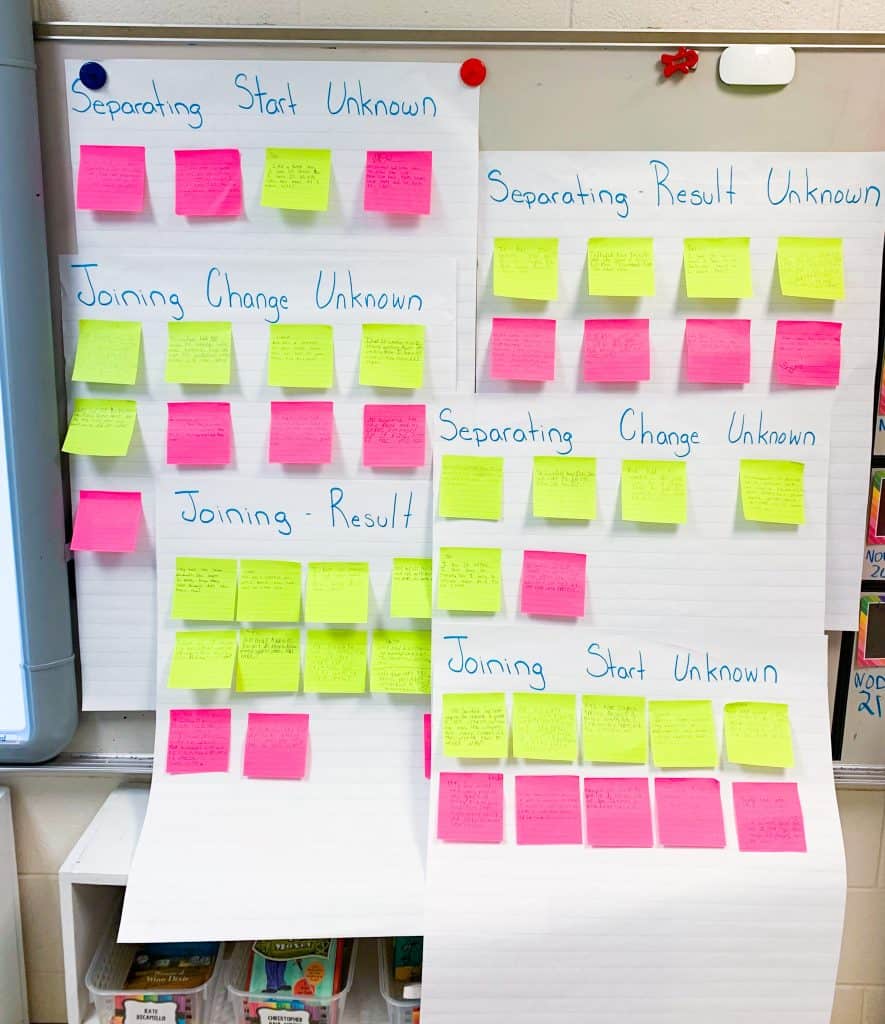
Have students write an example of each type of word problem on a separate sticky note. After writing the word problems, students should place the sticky notes on the corresponding sheet of chart paper. Once again, I like to follow that with extra practice.
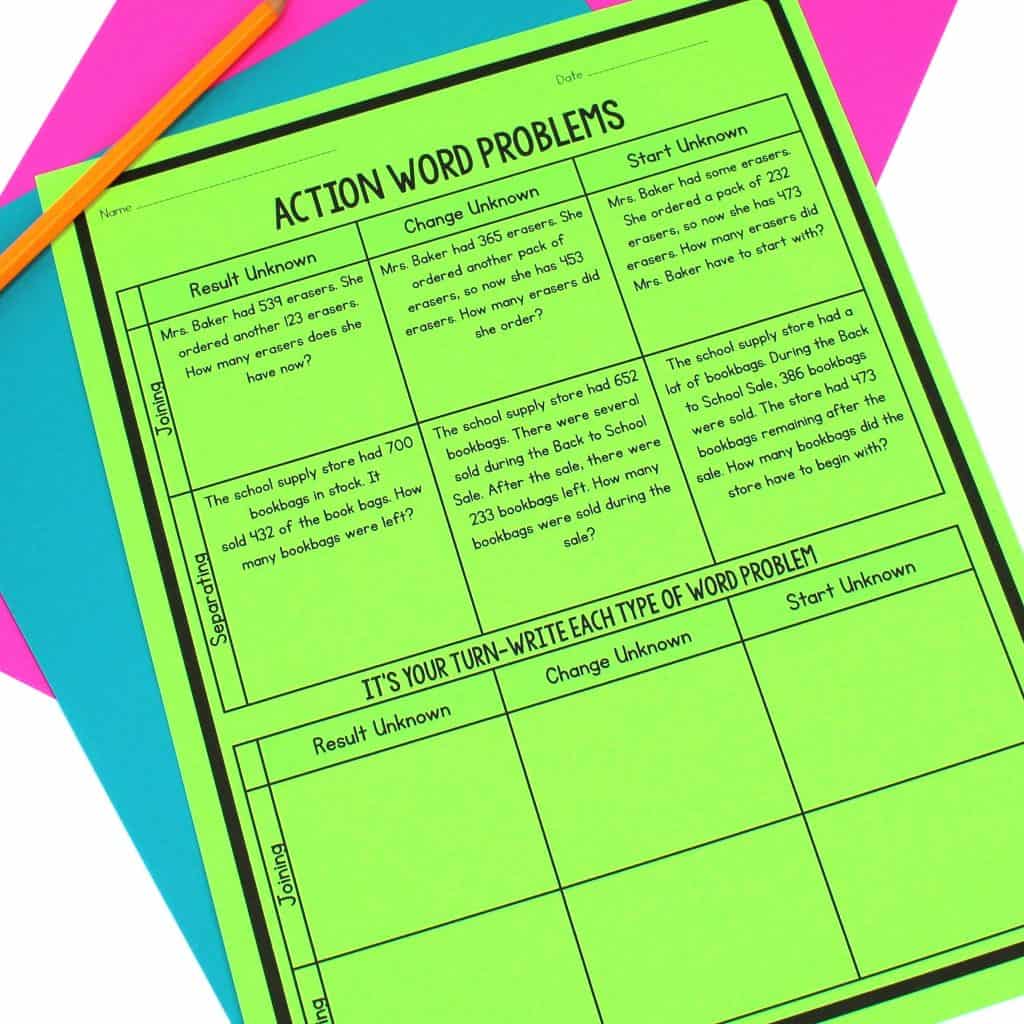
Over the years I’ve found that one of the best ways to slow students down when solving word problems is to have them color code and underline each part of the word problem. This is a game changer! I introduce it right away and try to make color coding become a habit for students. This is the expectation for every word problem they solve.
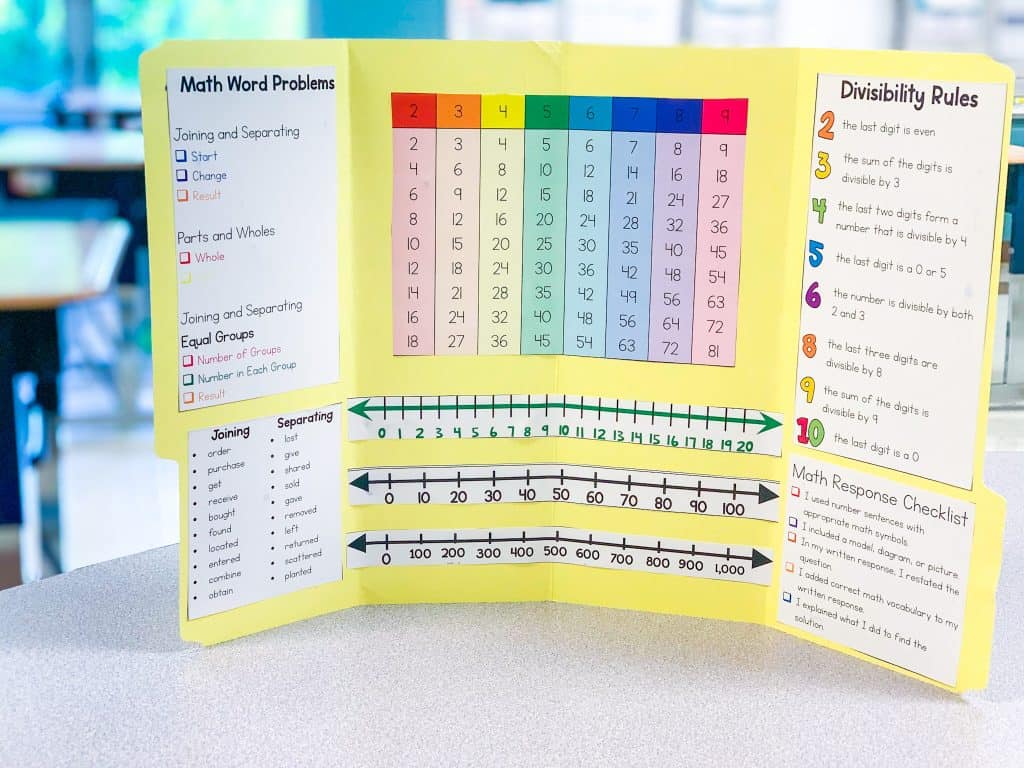
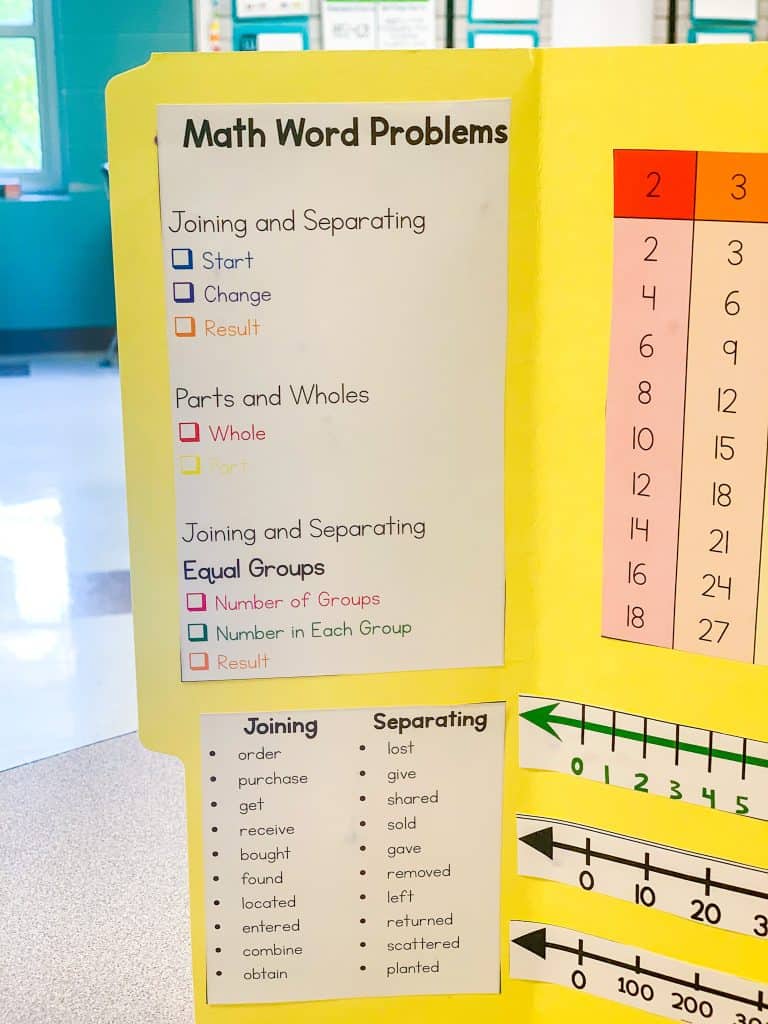
Types of Nonaction Word Problems
Students should then learn about nonaction word problems. I repeat the same process to teach the different types of nonaction problems: Comparing Difference Unknown, Comparing Greater Unknown, Comparing Fewer Unknown, Part-Part-Whole Whole Unknown, and Part-Part-Whole Part Unknown.
For extra practice, students can complete a Types of Nonaction Word Problems worksheet. These are the only word problems that I do not have students color code.
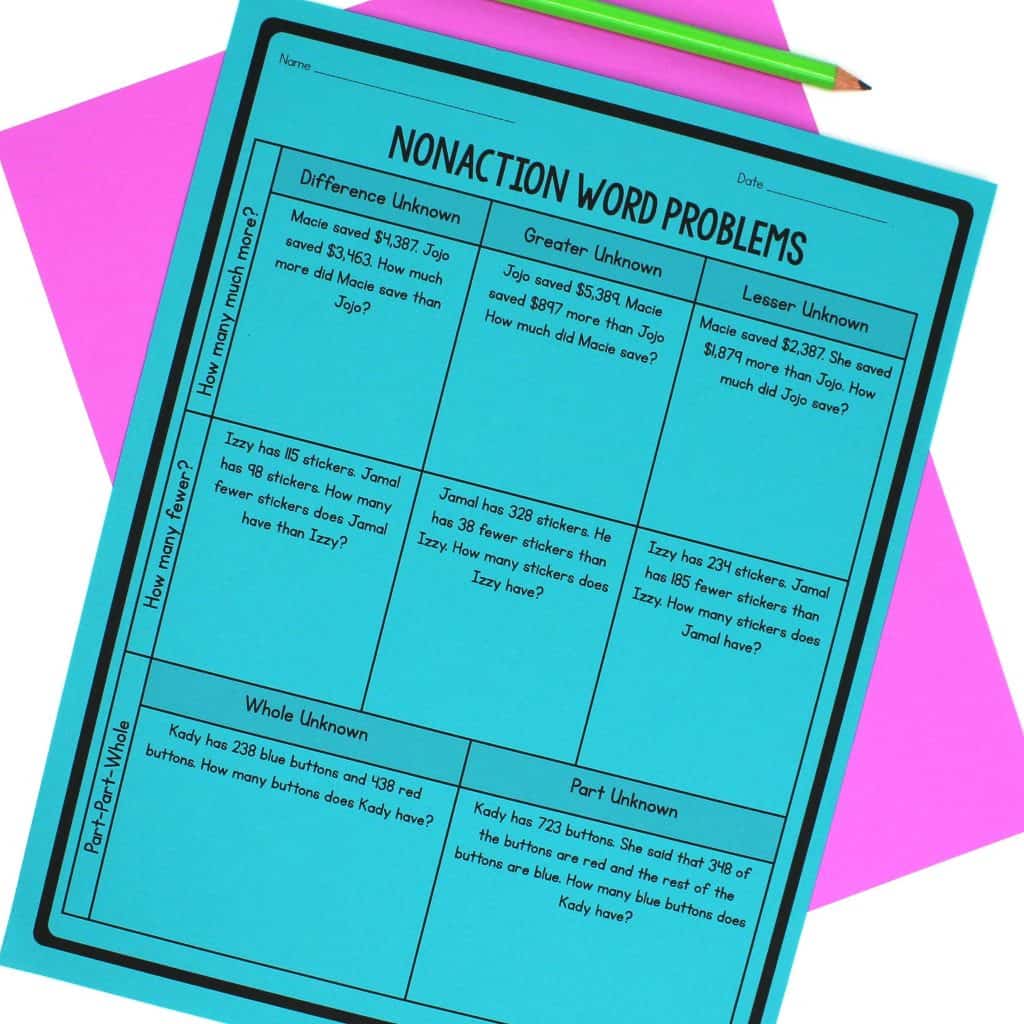
I do not make students memorize each type of problem. But, I do make sure they understand the work each number is doing within the word problem.
Situational Equations
Many times when students write equations, they write an equation that can be used to solve the problem, but it does not represent the situation of the word problem. Situation equations represent the action of the problem. Solution equations can be used to solve the problem.
Example: Some children were playing tag at recess. When another class came outside, eight more students joined them. Now there are 14 students playing tag. How many students were playing tag to begin with?
The solution equation would be 14-8=_____. However, the situation equation is ____ + 8=14.
To teach this, discuss each type of action word problem and have students notice the placement of each unknown quantity for each problem. Students should recognize that the unknown quantity naming the word problem also describes the location of the unknown in the situation equation.
Then discuss what type of solution equation would be most effective to solve the problem. Once again, follow this with extra practice.
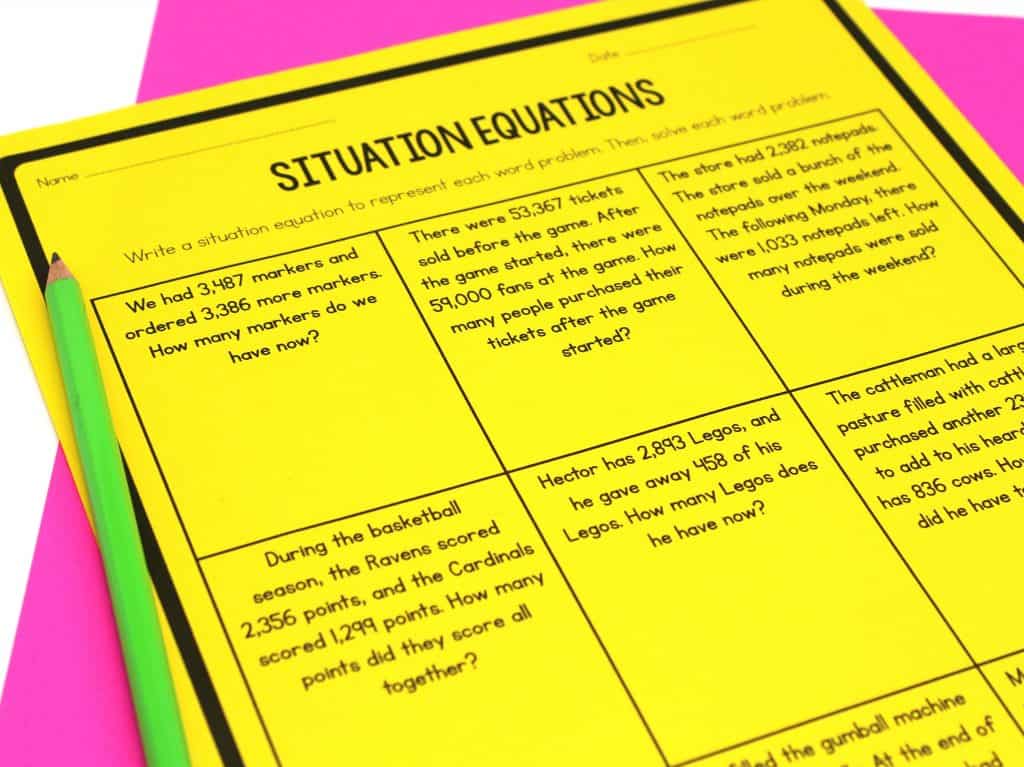
Each of the lessons above are from my Addition and Subtraction Unit. It’s a 4th grade unit, but I did create and include a version for 3rd grade students
Multiplication and Division Problems
When I begin teaching multiplication and division word problems, I don’t stop reviewing addition and subtraction word problems. It’s important to combine all operations to make sure students are seeking meaning in every word problem they solve.
The key to understanding multiplication and division problem situations is identifying the work each factor does. Students must consider the following:
- What do the numbers represent? What do they do?
- How can I represent the quantities with manipulatives or pictures?
- What number sentence best shows what is happening in the story?
Equal Groups
To fully understand equal groups, it is essential that students see the difference between the number of groups and how many objects are in each group. The table below can be used a starting place for thinking about equal group situations. It can also be a reference for students as they write their own word problems.
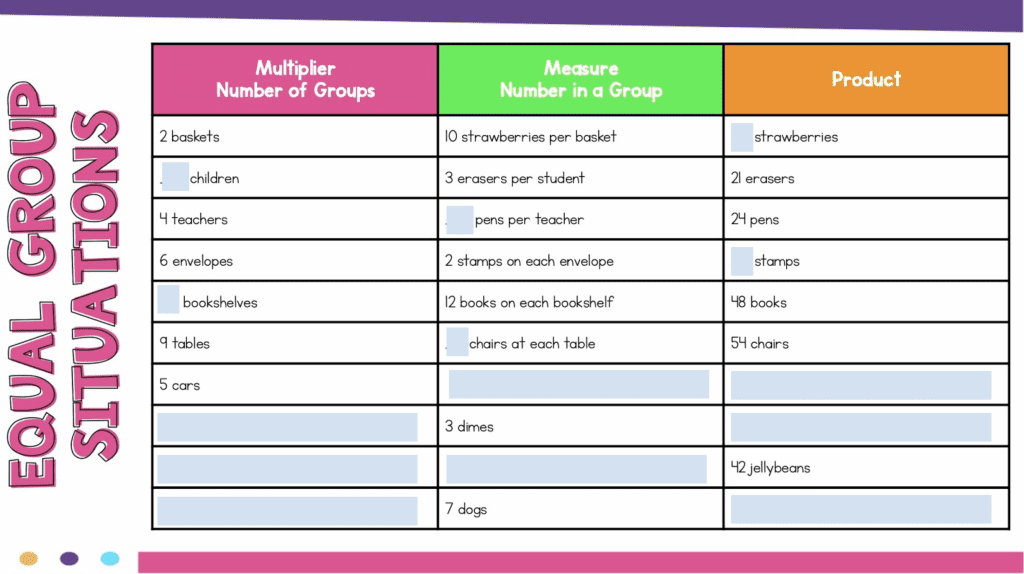 While the commutative property is helpful in memorizing multiplication facts, it is not always helpful in allowing students to develop a deep understanding of operation sense and the meaning of word problems. In word problems, most situations are not commutative, and students should be able to represent the situation accurately.
While the commutative property is helpful in memorizing multiplication facts, it is not always helpful in allowing students to develop a deep understanding of operation sense and the meaning of word problems. In word problems, most situations are not commutative, and students should be able to represent the situation accurately.
Questions like the one below allow you to see how deeply students understand multiplication situations, and it does a great job of illustrating how situations are not commutative.
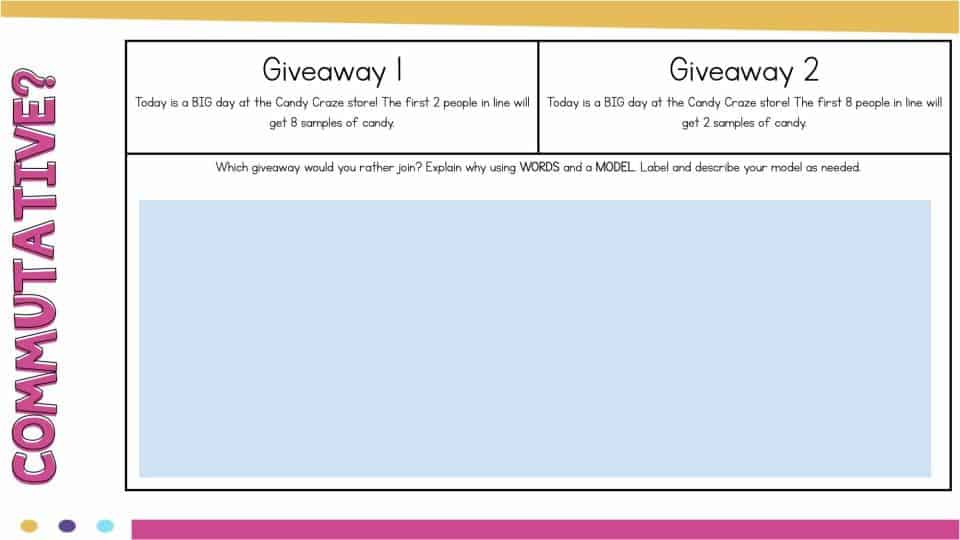
As we move into multiplication and division word problems, the highlighting continues. I chose different colors so students don’t confuse addition and subtraction color coding with the multiplication and division color coding. The word problems below show how this can be done digitally.
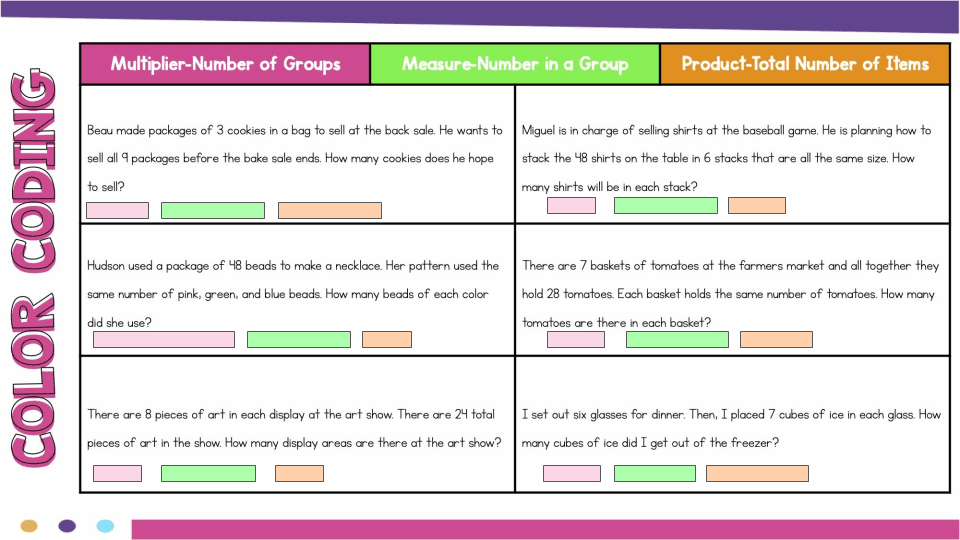
In the above problems, I have already sized the rectangles for students. However when all operations are combined, students may have to resize the highlighting rectangles.
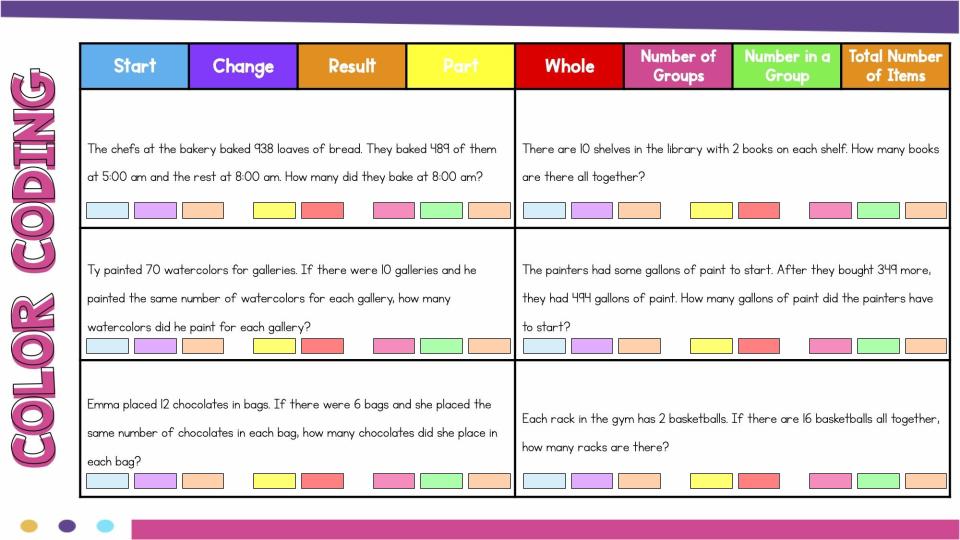
Multiplication Comparison
Multiplicative comparison problems often pose a challenge to students, as students tend to confuse additive and multiplicative comparisons. Students need the opportunity to experience acting out and building representations for this type of problem. These comparison problems should be interwoven with equal group problems.
To give students time to reason about these word problems, they can complete sorts where they discern between additive comparison problems and multiplicative comparison problems.
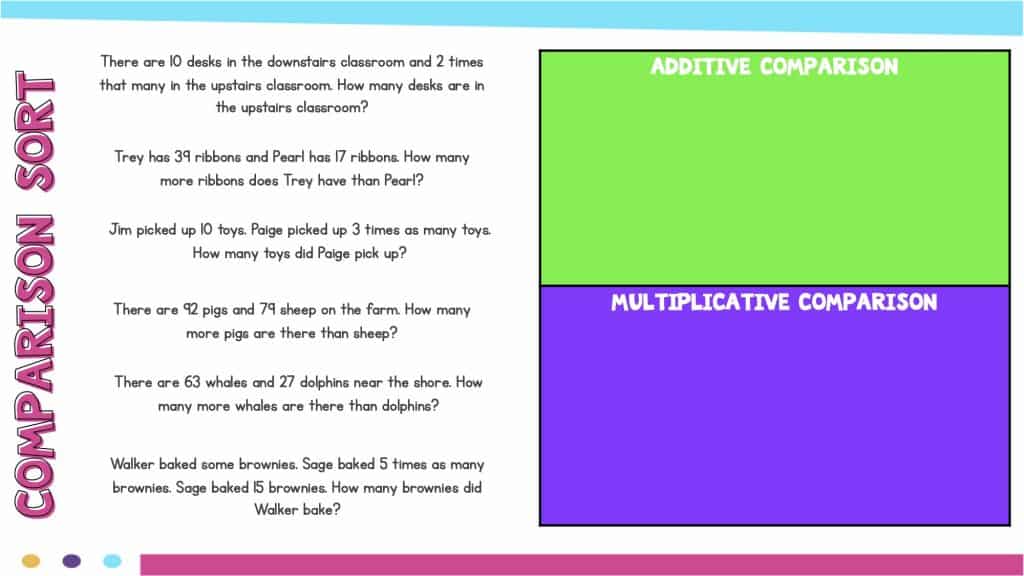
Students need multiple opportunities to work with multiplication as a comparison, and I hope to have a new post ready for that next week!
During your instruction, it is incredibly beneficial to have students write their own word problems. This takes their learning to a deeper level and it gives you a greater insight into your students’ understanding.
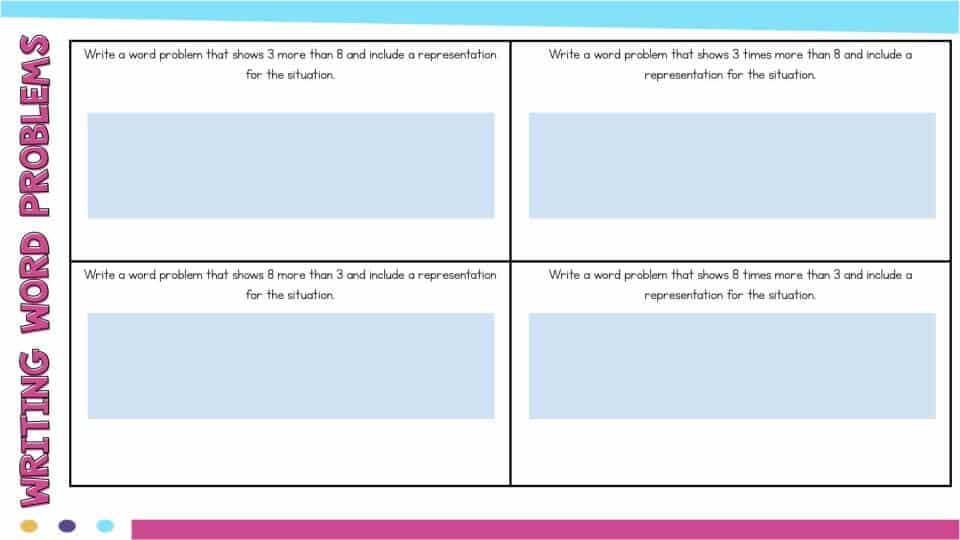
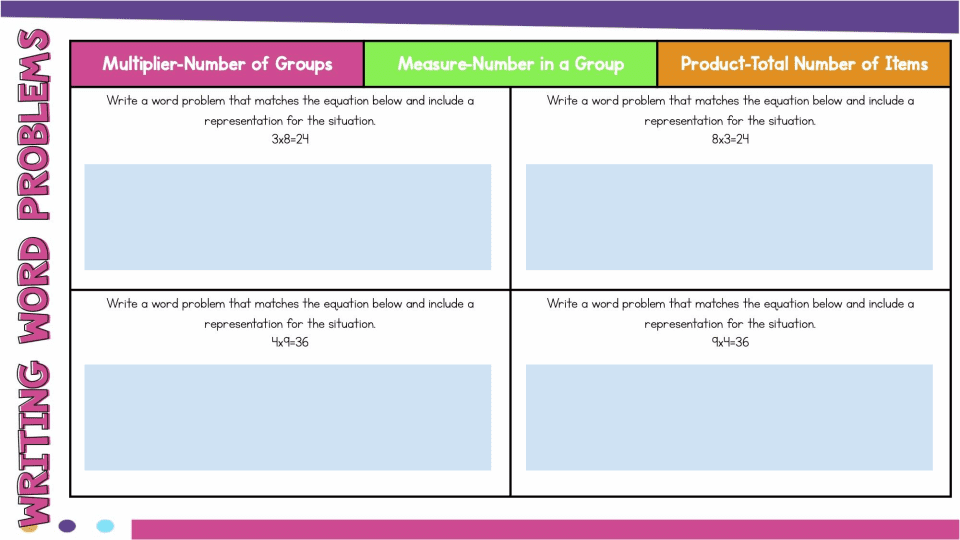
Error Analysis
Even using these strategies, You will still see errors and confusion, especially with situational equations. This is a process and this operational sense will be developed over time with consistent practice and instruction. Once I teach students the basics of word problems, I like to have students complete error analysis problems. It’s best to only complete one problem a day to allow deep conversations. The errors found in these problems are not computational errors. Instead, they’re errors in the representation of the problem.
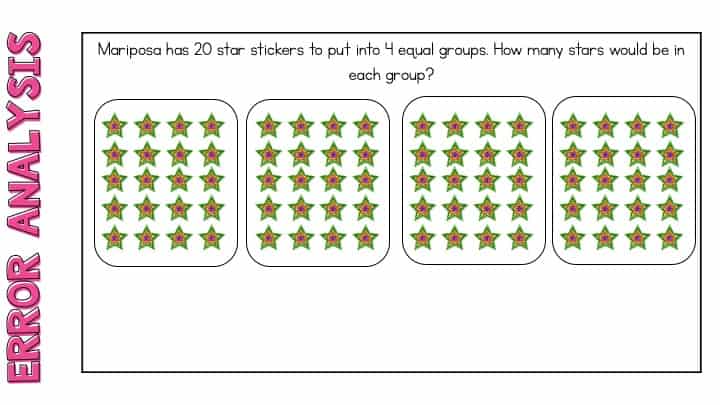
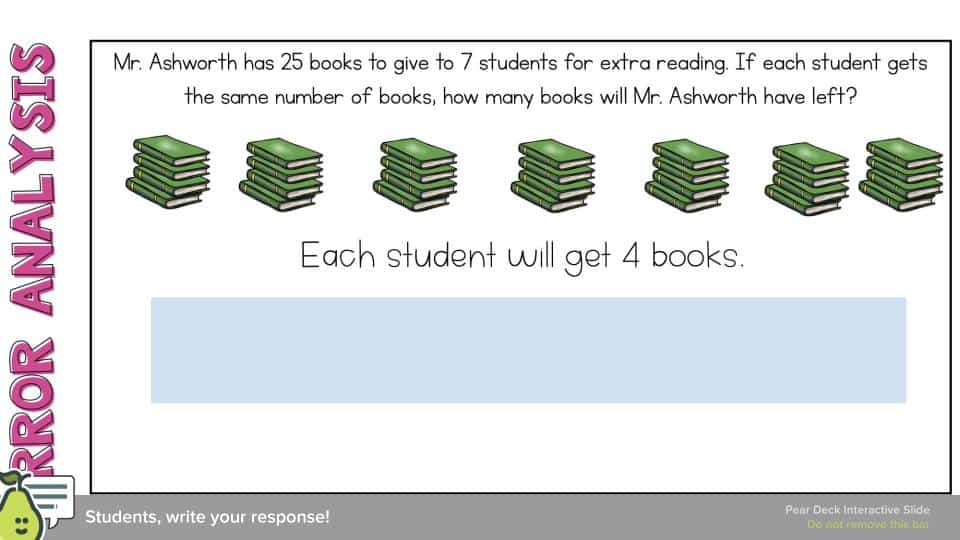
I included a Peardeck option for all of the error analysis activities. Of course you don’t have to use that option. It’s just a way to make the lesson even more interactive.
All of the slides above are from my Multiplication and Division Word Problem resource. You can find that resource here.
With or without the resource, I hope that this has helped provide you with ideas and strategies for teaching word problems. Let me know how it goes!



Excellent teaching skills being provided through experienced based methods. Too much helpful. Never seen such a thought provoking article before on this topic.